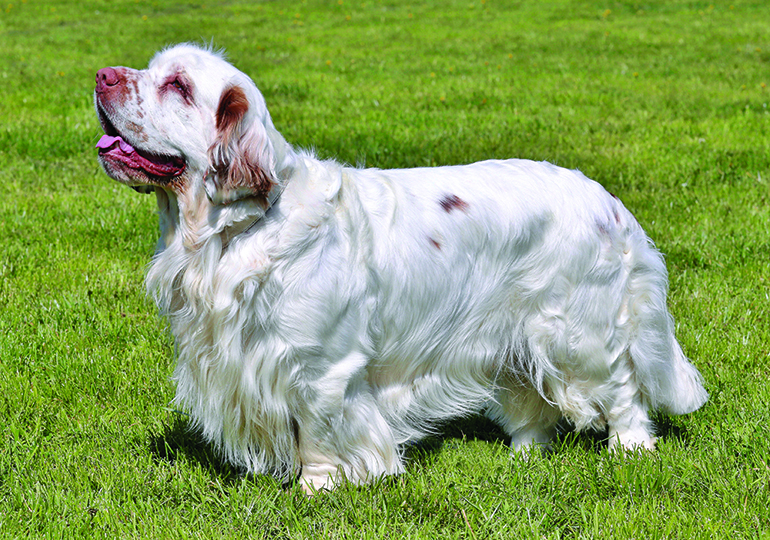Breeds
Clumber Spaniel

GROUP 3 - GUNDOGS
History
The Clumber Spaniel is named after the Duke of Newcastle’s Nottingham country estate, Clumber Park. The breed was definitely with the Duke prior to 1788, and seems to have been with the family even as early as the 1750s. A heavy, large white spaniel often featured in artwork throughout the British Isles and Europe for centuries before this. It was one of the first breeds to be named. The breed has been owned by the English Royal family for generations, HRH The Princess Royal currently has a small kennel for field work.
Characteristics
The Clumber is bred for hunting in heavy cover where its largely white coat makes it easy to see. The breed's strong build ensures it is able to penetrate dense undergrowth to flush or retrieve game. This breed possesses great stamina, is a silent worker with an excellent ability to track and a fit and well bred dog will not tire from a long day of moderately paced work.
Temperament
The Clumber Spaniel is not hyperactive but is active. The Clumber is a friendly, sociable and charismatic companion. The Clumber is gentle, loyal and affectionate, mostly dignified but is reserved with people and environments he has not met before.
Appearance
The Clumber has a bulky and strong hindquarter which balances well with the weight of the forehand making him ‘well balanced’, and heavy set onto short legs. This allows his body to appear longer than other breeds. His legs are not stumpy but shorter than ‘average’. His physique gives him strength and power to push through undergrowth, but the length of body to be able to climb over boulders and logs, and reach a long way onto a kitchen bench.
He is also notable for his facial expression, large feet, and soft to touch coat, and the free spread of his shedding white hair.
The Dogs Australia breed standard requires adults to be between 25 (minimum for adult females) to 34 kg (maximum for adult males). A large adult male should not be taller than 50cm at the withers nor less than 43cm, however the standard makes no requirements.
Health
Clumbers typically can be expected to live between 10-12 years of age, but with correct nutrition and and optimum environment will live to 15 plus years. However, sufficient exercise is needed if the Clumber is to avoid gaining weight and to avoid losing muscle tone and bone strength which are required throughout a healthy life.
The breed is often cited as being prone to hip dysplasia but if the dogs are bred to meet the requirements of the breed standard this is rarely a problem (Australia’s hip score record demonstrates this, but breeders must be very careful in choosing which dogs to breed to avoid a decline in this record). The breed has two confirmed autosomal recessive defective genes (PDP1def and EIC) that breeders must screen for to avoid producing unhealthy puppies.
As with poor hip joints, breeders must be careful in choosing which dogs to breed to avoid eye rim and shape issues which, if they develop, will cause pain and require surgery (yes, the pricey sort) (entropion/ectropion).
Maintenance
Clumber Spaniels have a generally low maintenance, thick, soft weather-resistant coat. To avoid shedding hairs falling, hair brushing and combing should be done on a regular basis.
The breed’s eyes and ears should be regularly checked. Trimming the feet on top and underneath, the feathering under the ear hole, from the wrist to the foot on the front legs and from the hock to foot on the hind legs every 3 weeks should be sufficient when regularly combed through
Suitability
The Clumber is happiest in a group living situation with a canine (preferably Clumber) friend for company. The breed usually adapts well to other non-dominant breeds, but can be just as content in a single dog family if he has a fair amount of human company throughout the day. He dislikes rigorous, repetitive, regimented training, prefers to learn through observation and will copy quickly as he has a great desire to interact with and please his owner, and revels in positive reinforcement techniques.
Generally, the breed is really very intelligent, and also stoic in the belief that what they learned was what was meant to be taught, so owners need to be aware of the their own inaccuracies in teaching a skill
Words: Diana Fenton & Jan Irving
Image: Shutterstock.com
In Conclusion
Now you know a little about the Clumber Spaniel, you may think that this is the dog for you. Before you make a decision, please make contact with the breed club or your State controlling body for purebred dogs. They will be able to give you information about available puppies and also suggest dog shows where you can see the breed and speak to breeders. In this way you will gain a better perspective of the Clumber Spaniel and its needs, and whether this breed would suit your lifestyle.


